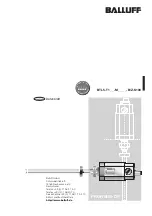
– –
– –
22
23
Frequency Hopping Spread Spectrum
The module uses Frequency Hopping Spread Spectrum to allow operation
at higher power levels per regulations and to reduce interference with other
transmitters. The module is configured for operation in one of 6 different
hopping sequences. Each sequence uses 26 channels for the high RF data
rate or 50 channels for the low RF data rate. Modules must use the same
hopping sequence to communicate. Assigning different hopping sequences
to multiple networks in the same area minimizes the interference.
When the module is awake and not transmitting, it rapidly scans all
channels for a packet preamble. When a module starts transmitting at the
beginning of a new channel, it transmits a packet with a long preamble of
alternating 0 and 1 bits. This long preamble is sufficient to allow receiving
modules to scan through all of the channels in the hopping sequence and
find it. Modules that are scanning detect the preamble and pause on that
channel, waiting for a valid packet.
If a packet is received with a valid CRC (unencrypted) or authentication
(encrypted), the header is examined to determine whether the module
should synchronize to the transmitter. Synchronization requires that the hop
sequence matches and that the message is addressed to the receiver.
When synchronized, the receiver stays on the current channel to either
transmit a packet or to receive an additional packet. Additional packets
transmitted on the same channel within the time slot use short preambles
since the receivers are already listening to the current channel.
At the end of the time slot for the current channel, all modules which locked
to the original transmission switch to the next channel in the hop sequence.
The first transmission on each new channel has a long preamble.
A receiver that has synchronized to a transmitter continues to stay in
synchronism by staying on the received channel until the expiration of the
time slot, then waiting on the next hop channel for the duration of the time
slot. If no further packets are received, the receiver loses lock and reverts
to scanning. This allows the receiver to stay synchronized for a short while
if a packet is not received correctly.
The module supports the option to send the long preamble with every
packet rather than just the first packet on each channel. This can be
beneficial for systems that have modules asleep most of the time. It gives
modules that just woke up the chance to synchronize to any transmitted
packet instead of having to wait for the transmitter to complete its time slot
and jump to the next channel. This can reduce the synchronization time
and power consumption of the sleeping nodes.
Compatibility with the 250 Series
When DSN mode is used with a specific address, the module can
communicate with 250 Series modules at UART data rates of 38,400 to
115,200 bps, non-encrypted. For other addressing modes, the HumPRO
TM
Series modules can be configured to operate with them. Setting the
register to 0x00 enables the compatible operation. This allows
mixed-mode systems and upgrades of legacy products that still maintain
backwards compatibility. Only the higher baud rates are compatible.
The main feature of compatibility operation is that it configures the same
addressing methods used by the 250 Series. These methods are more
susceptible to interference from adjacent networks of 250 Series modules
which use DSN (GUI) broadcast messages. Please see Reference Guide
RG-00105 for more details.
Networking
The HumPRO
TM
Series modules can be used to create many types of
wireless networks. The modules do not provide network routing since the
internal memory size of the module would limit the overall network size. The
HumPRO
TM
can work as the MAC/PHY layers of a network stack and the
memory and processing speed of the external microcontroller can be sized
according to the size of the network that is needed for the application.
This requires more software development, but avoids the cost of adding
extra memory on the module for applications that don’t need it. Linx can
assist with network frameworks and concepts and can create custom
designs on a contract basis. Contact Linx for more details.
Содержание EVM-900-PRO
Страница 1: ...HumPRO ATM Series 900MHz RF Transceiver Module Data Guide...
Страница 60: ...114 115 Notes...















































